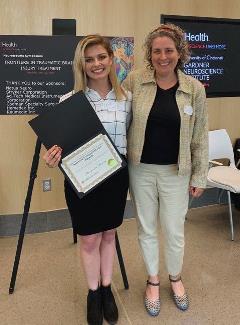 Allie Lowery, winner of the data blitz
Allie Lowery, winner of the data blitz
competition,
and her mentor Dr. Jen McGuire
Individually, PhD’s and MD’s can accomplish amazing things, but bring the two groups together for a common cause and their potential to succeed is limitless. To foster this joint communication, The Collaborative for Research on Acute Neurological Injuries (CRANI) hosted the University of Cincinnati’s (UC) first ever Neurotrauma Symposium at the new UC Gardner Neuroscience Institute on May 2019.
Laura Ngwenya, MD, PhD and Assistant Professor of Neurosurgery at the UC College of Medicine and Director of the Neurotrauma Center at UC Health, established CRANI in 2016 along with Jed Hartings, PhD, and Brandon Foreman, MD, of the University of Cincinnati. The group aims to “establish a community and curriculum for collaboration and sharing of resources/expertise on the study of acute neurological injury across the University of Cincinnati and affiliate institutions”.
Ngwenya stated that her goal for the symposium was “to bring awareness about [traumatic brain injury] TBI and our efforts at the UC Neurotrauma Center to the broader community of healthcare providers and researchers in the greater Cincinnati area.” The event saw presentations from MD’s and PhD’s alike covering all aspects of TBI such as medical treatments and research advances.
Ngwenya opened the symposium highlighting the prevalence of neurotrauma in Ohio and across the United States. There was a large focus on the importance of TBI research and communication for the betterment of patients. In the past two decades, there have been over 4,000 preclinical studies on TBI and over 200 phase 2 or greater clinical trials on TBI. However, there is still no FDA approved medication aimed at treating TBI. This puts an emphasis on research collaboration and better advancement of these studies.
One of my favorite aspects of the symposium was the research data blitz, where trainees had the opportunity to present a highlight of their research in only 10 minutes. Allie Lowery, a recent UC graduate who had conducted research throughout her undergraduate career, was the winner of the data blitz competition. Allie’s presentation gave a synopsis of her work, the larger implications, and her future research plans. Presenting your research in only 10 minutes can be difficult, and Allie presented with the confidence and knowledge that every great presentation has. Allie’s project studies the effect of pioglitazone, an FDA approved anti-diabetic medication, on working memory in a rat model of TBI.
“We saw that pioglitazone increased working memory performance in a radial arm maze behavior task, although the exact neurophysiological mechanism of this drug still needs to be clearly elucidated. Pioglitazone increased hexokinase activity, although this was not due to an upregulation of the enzyme or glucose transporters.”
Allie plans to continue this project and conduct further studies on the genomic level using single nuclei rather that whole tissue samples. She also noted that the CRANI data blitz gave her great experience in giving talks about her research since this was only the second time she has given a talk. The data blitz was no doubt a valued aspect for all members that participated.
Of the various organized talks throughout the day I felt the strongest connection to Dr. Michael Goodman, M.D, presentation on Military Advances in TBI research. There is a high, 65-81%, rate of blast induced injury. One of the key issues with blast trauma is that it isn’t an isolated injury, the damage spans to multiple body regions. An additional challenge is faced when trying to evacuate injured personnel from the battle zone. Multiple air-based evacuations expose those injured to various in-flight stressors that could further affect their injuries. The Goodman lab aims to mimic some of these stressors, particularly low oxygen levels, low pressure, and vibration to see how these factors affect outcomes in animal models of TBI.
“Overall the event was a great success and I am grateful for the support of the attendees and sponsors which have allowed us to make the UC Neurotrauma Symposium an annual event. I’m looking forward to next year!” says Ngwenya.